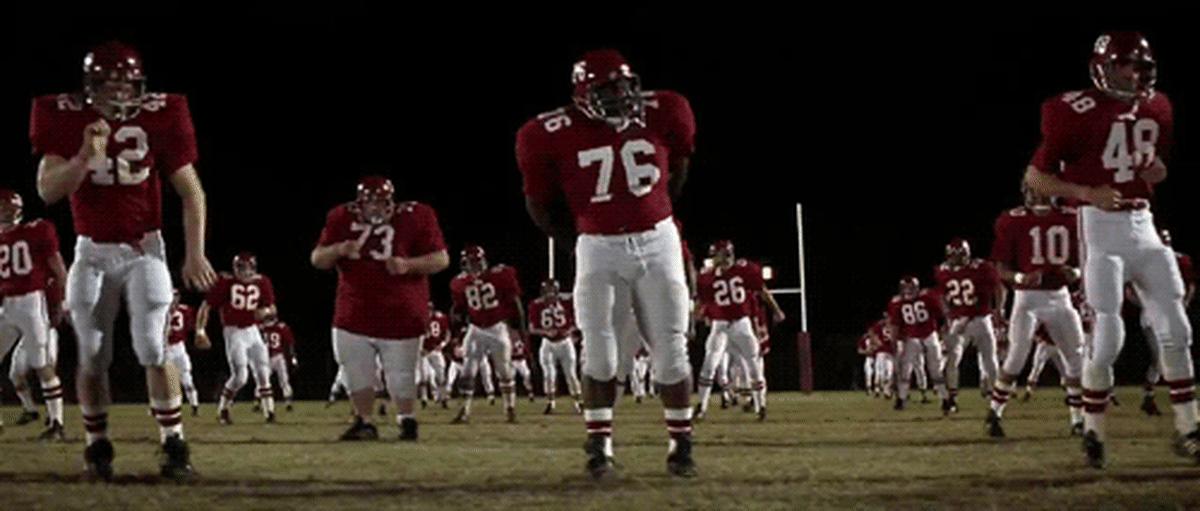Fake Fandom: The fictional stadiums that made us cheer

The chance your team will not only win games, but the entire championship goes up dramatically when your team is fictional. And fictional teams need fictional stadiums to wow their fans, make the unthinkable happen and have a few theatrics along the way (here’s looking at you shattering stadium lights in The Natural). We look at some of the best Hollywood has when it comes to fictional stadiums.
The Natural, 1984

Roy Hobbs. Man, could Roy Hobbs hit the cover off the baseball. With the film set in the 1930s, The Natural chose Buffalo’s War Memorial Stadium, built in 1937, to stand in as the historic home of the New York Knights. (The lone Wrigley Field scene was actually filmed at Buffalo’s All-High Stadium.) With half a million dollars set aside to turn an aging War Memorial Stadium—it was torn down just a few years after filming The Natural—into a nostalgic home, War Memorial gave Roy Hobbs a place to wow. And shatter lights.
The Hunger Games, 2012

We’re not saying that the folks of Panem have their morals tuned in correctly when it comes to sports, but they sure do know how to create a fantastical new stadium every year. With the Hunger Games held annually, Gamemakers must devise a new “arena” and use a wildly changing array of terrain, traps and treatments within the force field that confines it. While they don’t allow spectators inside the venue, the all-encompassing camera access makes the Hunger Games a must-see (the killing aspect probably did that a bit too). With 75 different arenas in Panem history, the list of features proves endless. Endlessly disturbing, that is.
Field of Dreams, 1989

We just had to include a cornfield in Iowa. How could we not? Here’s a case of a fictional stadium—it had some bleachers, remember—turning real, as the Lansing Family Farm in Dyersville, Iowa, became a tourist attraction following the movie. But here’s to show, some of the best stadiums have an organic growth to them, a real connection to the environment.
A League of Their Own, 1992

With a capacity under 3,000, League Stadium in Huntingburg, Indiana, was the perfect fit as home of the Rockford Peaches in A League of Their Own. The historic venue opened in 1894, but underwent a renovation for the movie, retaining the old-school charm, but spruced up with the bunting and fanfare of the movie. About an hour away in Evansville, Indiana, Bosse Field, which opened in 1915 and is still in use today for minor league ball, took the stage as a secondary venue, the home park of the Racine Belles. A little fictional dressing did wonders for these two venues.
Remember the Titans, 2002

Real life gets muddy when you mix in some fiction. While Remember the Titans was about Virginia high school T.C. Williams, the set of the school in the movie is really Druid Hills High School. But this movie is about football too and Druid Hills didn’t have a stadium, so filmmakers moved around the Atlanta area, stopping mainly at Sprayberry High School in Marietta, Georgia, for the football scenes. Berry College and Paulding County High School also host fictional T.C. Williams’ games. Victory Stadium, which did host the real championship that involved T.C. Williams, played itself in the movie, although the venue has since been torn down.
Dark Knight Rises, 2012

You may think the stadium in this superhero film is Pittsburgh’s Heinz Field, but you’d be wrong, fictionally speaking. The stadium in Dark Knight Rises is the home of the Gotham Rogues. While a few cosmetic changes were made to eliminate the Steelers from the venue and fill it with Rogues-looking insignias, the real work came on the field when this stadium went super fictional by blowing up all around the players during a kickoff return. Yeah, that part was fake.
The Sandlot, 1993

Okay, we know, using the word stadium for The Sandlot constitutes a major stretch. But really, stretching out the realistic form fits for The Sandlot. Using an empty field in the westside neighborhood of Glendale in Salt Lake City, filmmakers transformed dirt and grass into a stadium able to tug away at movie-watchers’ hearts. Of course, reality followed fiction, as the “sandlot” was preserved after the movie to keep the hopes and dreams—and tourist draw—alive.
Space Jam, 1996

The bones of the arena in Tune Land’s arena don’t look all that different from what you would expect—although we do like the cool lighting in the suites—in a typical NBA arena. Although, that is as about as far as normalcy goes in an arena filled by cartoon fans and cartoon happenings. Oh, so very fictional.
Cars, 2006

Lightning McQueen knew only about speed, not teamwork, skill or strategy. He learned every lesson he could ever dream of by spending time in Radiator Springs, especially during those one-on-one races and solo practice times on the Radiator Springs race track. With friends and townsfolk (these are vehicles, mind you) ringing the track, McQueen learned the art of handling and so many other life lessons from Doc, from the town and from the track. This is the best of what a fictional stadium can teach us.
Tim Newcomb covers stadiums, design and gear for Sports Illustrated. Follow him on Twitter at @tdnewcomb.
